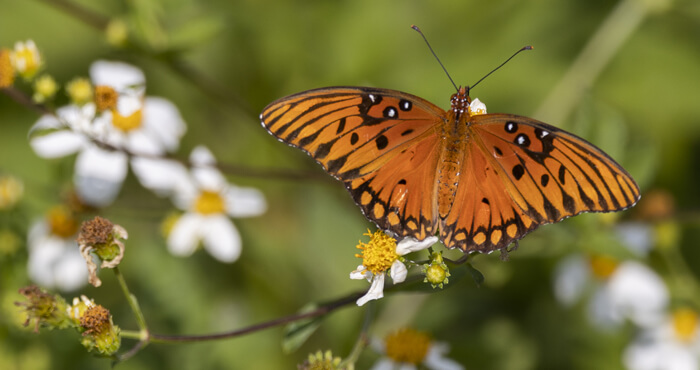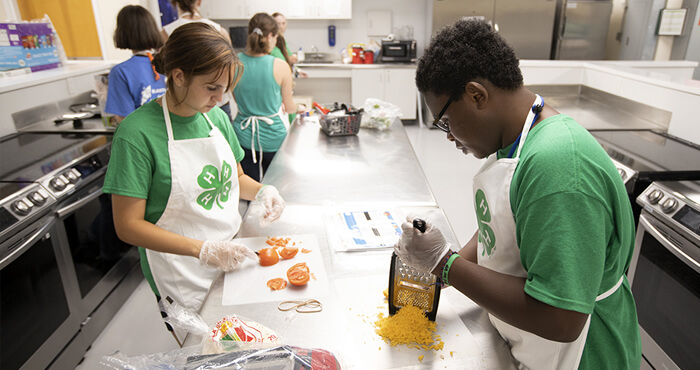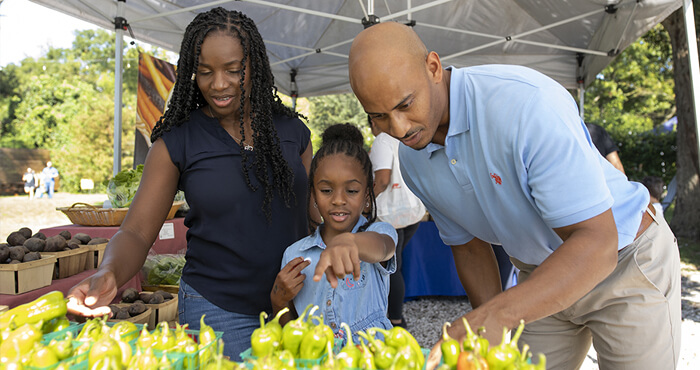
MOLE CRICKETS
GET RID OF THESE INVASIVE PESTS
Invasive mole crickets are a serious plant pest for many Floridians. These insects can do major damage to any species of turfgrass, as well as to pastures, forage crops, and vegetables. So, how can you get rid of them? While it is unlikely that you will completely get rid of them, UF/IFAS research since the 1980s suggests that biological control with the Larra bicolor wasp and an insect-parasitic nematode (microscopic worm) may be more effective than conventional pesticides.
WHAT ARE MOLE CRICKETS?
Mole crickets are a unique and unusual family of crickets that spend most of their life underground and have modified “hands” (front legs) that help them tunnel through the soil (Hence, the name mole cricket). These insects are common turfgrass pests throughout Florida and the southeastern U.S. Several species occur around the world and cause damage to multiple crop species.
In Florida, three species of mole crickets are considered pests: the tawny (Neoscapteriscus vicinus), southern (Neoscapteriscus borellii), and short-winged (Neoscapteriscus abbreviatus) mole crickets. There is also one native species, the northern (Neocurtilla hexadactyla) mole cricket that is found throughout the eastern U.S., although this species is not considered a pest.
WHAT DO THEY DO?
Mole crickets tunnel through the soil, often close to the soil surface, severing grass roots and causing the earth to bulge upwards. They also eat the roots and shoots of plants where they are tunneling, most commonly grasses. Mole cricket tunneling and feeding damage looks like ugly brown patches of dying or dead grass, which are typically replaced by weeds. Predators such as raccoons, armadillos, and birds may further dig up the turf to snack on the crickets, which creates even more of a mess.
Sod farms, home lawns, golf courses, and pastures all frequently host mole crickets. Any species of turfgrass can be damaged by mole crickets, but they particularly like bahiagrass and bermudagrass.
WHEN ARE THEY ACTIVE?
Mole crickets are active year-around in Florida, but do the most damage during spring (March through June) or fall (late August to early October) when they are mostly adults. Mole crickets have one generation per year, with eggs typically being laid in April and May. Not only can mole crickets tunnel through the soil, but the adults can also fly long distances. In fact, an adult male mole cricket will sit at the entrance to his tunnel and call for adult females, who fly in to find him. Mole crickets are nocturnal, which means they are actively calling, tunneling, and flying at night.
HOW CAN I TELL IF I HAVE MOLE CRICKETS?
An easy way to determine whether there are mole crickets in your yard is to mix 1.5 fluid ounces of liquid dishwashing soap into 2 gallons of water and pour the mixture over 4 square feet of turf. If there are live mole crickets tunneling in the soil within that area, they will crawl to the surface to get some fresh air in under three minutes. If two to four mole crickets appear within three minutes of application, corrective action is justified.
OPTIONS, PLEASE?
For many years, pesticides have been used to combat these winged, tunneling pests, but over the past 35 years, University of Florida researchers have been investigating and developing alternative methods of control. While liquid and granular insecticides do remain a viable option for many golf courses, the options are often limited in residential lawns or pastures.
Beginning in the 1980s, UF/IFAS scientists introduced beneficial insects into Florida that have been attributed with drastically reducing invasive mole cricket populations throughout the state. These organisms more easily do away with the little diggers--at virtually no cost to you.
Classical Biological Control: A Natural Approach
OVERVIEW
Many insects have become pests in the United States because they came from other regions of the world and escaped their predators. With nothing to keep them in check, their populations often explode. Southern and tawny mole crickets, who arrived as stowaways on ships from South America around the year 1900, are perfect examples.
What is a Biocontrol Agent?
Biocontrol (short for "biological control") means using a beneficial organism to combat a pest organism. Classical biological control is where scientists look to an exotic invasive pest’s native land to find its natural enemies and then import them into our environment where the exotic invader has become a problem.
What are the Benefits?
Biocontrol organisms can have multiple benefits. They are typically safe to humans, pets, and livestock; require little to no maintenance once established, and when successful, have minimal or no impacts on non-target organisms. These pest control agents can also provide long-term, extended control of pest populations without reintroduction or reapplication, which pesticides cannot provide.
Why Not Pesticides?
Pesticides are a valid option for dealing with mole crickets--sometimes a necessary one--but they do have drawbacks. Pesticides require regular reapplication, which costs money and time. They also create potential hazards by posing potential risks to non-target beneficial organisms or infiltrating groundwater.
Good and effective biocontrol organisms are highly host-specific, meaning they only or primarily attack the target pest. Biocontrol organisms seek to establish population equilibriums (balance) rather than bombard a lawn or garden with chemicals that control or affect every insect contacted. For this reason, biological control rarely completely rids an environment of a pest, but rather, reduces the pest below levels that are damaging to host plants.
SPECIFIC BIOCONTROLS
The Larra Wasp (Larra bicolor)
The Larra bicolor wasp, a natural enemy of each invasive mole cricket species, is called a "parasitoid" because its young feed and develop on mole crickets at the expense of the cricket. In contrast, the adults feed on nectar from flowering plants. The adult wasp lays an average of two to three eggs per day and up to one hundred in a lifetime. Each one of these eggs will be laid on an individual mole cricket.
When an egg hatches, the wasp larva sticks to the live mole cricket, feeding off its blood. When the wasp is fully grown, it consumes the mole cricket it has lived on. There is a one hundred percent death rate for mole crickets that are parasitized by a Larra wasp.
Each generation of Larra wasps kills about twenty-five percent of the local mole cricket population--and there are three generations of wasps per year, compared to one generation of mole crickets.
Larra bicolor wasps do not sting humans unless caught and held in the hand. These insects are solitary, which means they have no nest to defend. It is more beneficial for them to flee than to sting.
To-date, the Larra wasp has been found in most Florida counties and is documented as far north as North Carolina.
Host Plants for the Larra Wasp
It is relatively simple to attract and promote these wasps on your own property. Simply plant their favored host flowering plants, Spermacoce verticillata, Chamaecrista fasciculata, and/or Pentas lanceolata (white) in the vicinity of your lawn, golf course, or pasture. Then, sit back and watch nature work.
Commonly known as "shrubby false buttonweed," "partridge pea," and “Star flower / Pentas,” respectively. Spermacoce verticillata, Chamaecrista fasciculata, and Pentas lanceolata are much less expensive than chemical treatments and require little to no maintenance. Spermacoce verticillata and P. lanceolata are both not native to Florida, while C. fasciculata is native. It is important to note that S. verticilata and C. fasciculata can both grow aggressively and quickly spread to fill in a planting area.
Each plant is perennial in Florida and produces yellow or white odorless, compound flowers. In North and Central Florida, shrubby false buttonweed flowers from July through the first freeze. Partridge pea gernally blooms from May to October. In South Florida, they may bloom year-round.
You can plant shrubby false buttonweed or partridge pea from seed or as a young plant. Pentas do best if planted as a small plant. Contact your local county Extension office for information about where you may be able to purchase these plants. Chamaecrista fasciculata is frequently available from most wildflower seed producers, including the Florida Wildflower Co-op. However, S. verticilata is not widely produced and sold. Pentas are commonly sold at garden centers or nurseries, but it is important to get P. lanceolata and ones that produce white flowers. Nurseries specializing in Florida native plants may stock one or all of them.
Steinernema scapterisci
UF/IFAS scientists also traveled to South America and found these parasitic nematodes, or microscopic round worms, attacking southern and tawny mole crickets in their native land. Beginning in the 1980s, Steinernema scapterisci, an insect-parasitic nematode, was also introduced into Florida as a classical biological control agent to attack invasive mole crickets.
These beneficial organisms swim through the soil where they find mole cricket adults to attack. Once the nematode has infiltrated the mole cricket’s body, it releases a bacterium, which ultimately kills the cricket and allows the nematode to reproduce. After it reproduces, several hundred will erupt from the mole cricket’s body and swim into the soil in search of more hosts.
Recent UF/IFAS research has found that in 2018, southern and tawny mole crickets in north-central Florida are infected with this parasitic nematode, indicating that it has successfully established and spread across Florida. Ongoing research is investigating its current distribution and the effect it is having on mole crickets in the U.S.
ADDITIONAL RESOURCES
There is an extensive history of research conducted on mole crickets in Florida over the past several decades. As a result, we have a good understanding of southern and tawny mole cricket behavior, ecology, and management. An economic analysis conducted in 2016 determined that the mole cricket biological control program has saved the Florida cattle industry over $13 million in annual pest control, crop loss, and mitigation costs.
Despite this success, ongoing UF/IFAS research continues to investigate important questions regarding the distribution and management of these invasive pests. For more information on mole crickets and biological control agents, visit IPM Florida's Mole Cricket Success Story, and refer to the following publications:
Resources
Other UF/IFAS Sites
- Gardening Solutions
- Entomology and Nematology Department
- Environmental Horticulture Department
- FAWN: Florida Automated Weather Network
- Florida-Friendly Landscaping™ Program
- Florida Master Gardener Program
- IPM Florida
- Pesticide Information Office
UF/IFAS Publications
- Florida-Friendly Landscaping™ Program
- Central Florida Gardening and Landscaping Fact Sheets
- Starting a Garden
State & Federal Agencies
- Florida Department of Agriculture and Consumer Services (FDACS)
- Florida Department of Environmental Protection (FDEP)
- Florida Energy Systems Consortium (FESC)
- U.S. Environmental Protection Agency (EPA)
- USDA Plant Hardiness Zone Map--U.S. National Arboretum
Organizations & Associations
- American Community Gardening Association
- American Horticultural Society
- Florida Native Plant Society
- Florida Nursery, Growers and Landscape Association (FNGLA)
- North American Native Plant Society
Other Sites & Publications
UF/IFAS Mobile Web Apps



.jpg)

.jpg)
